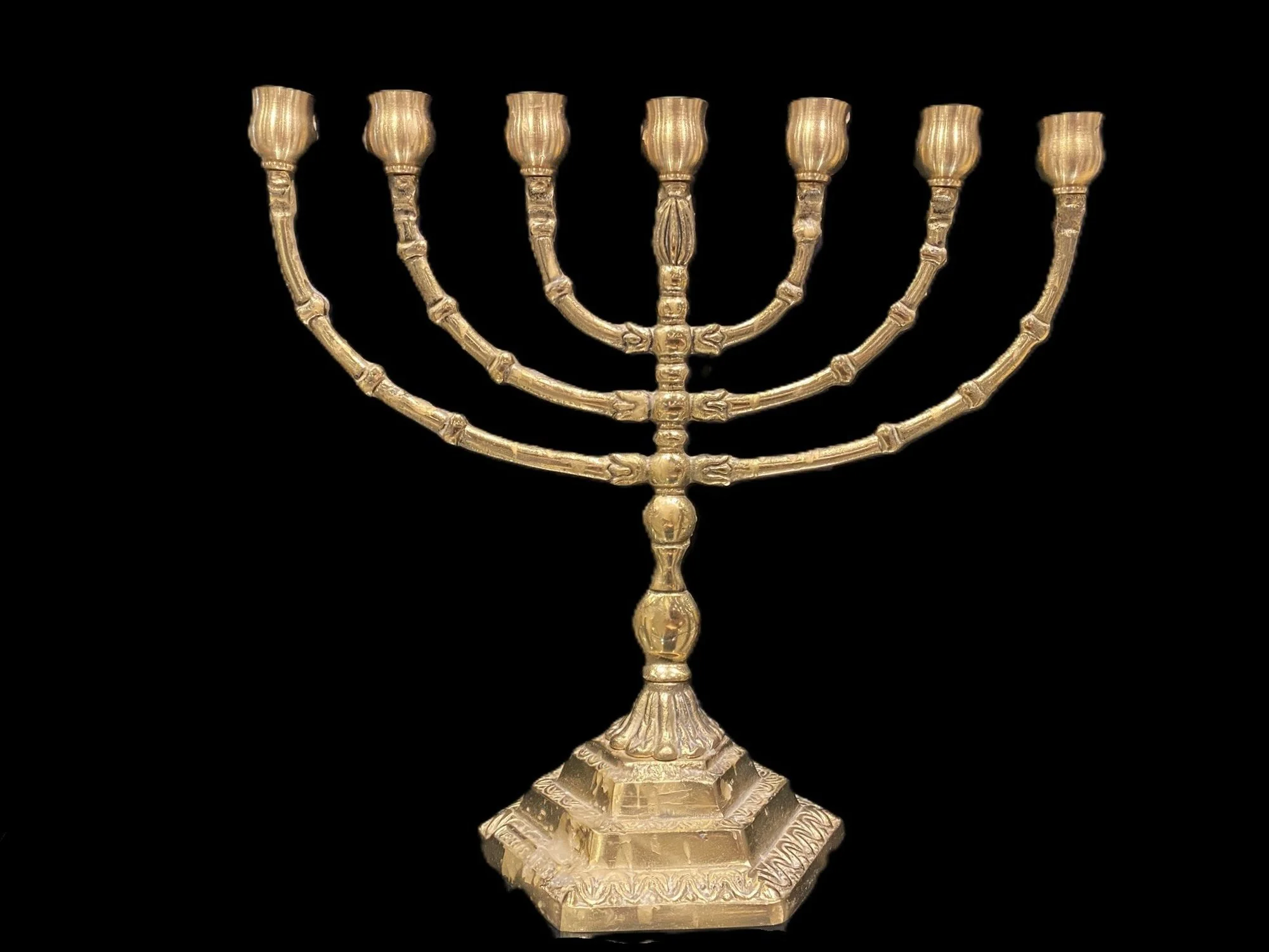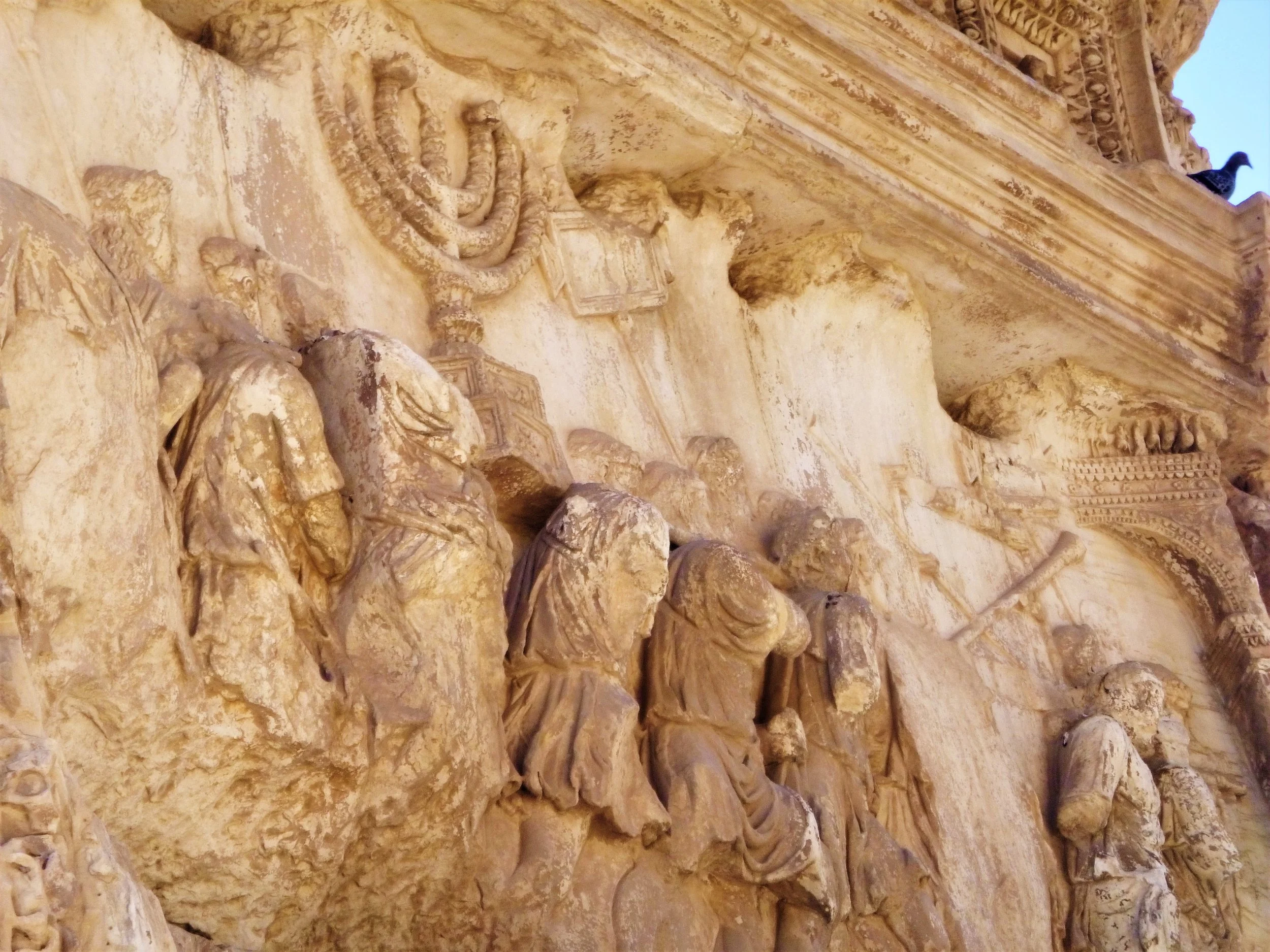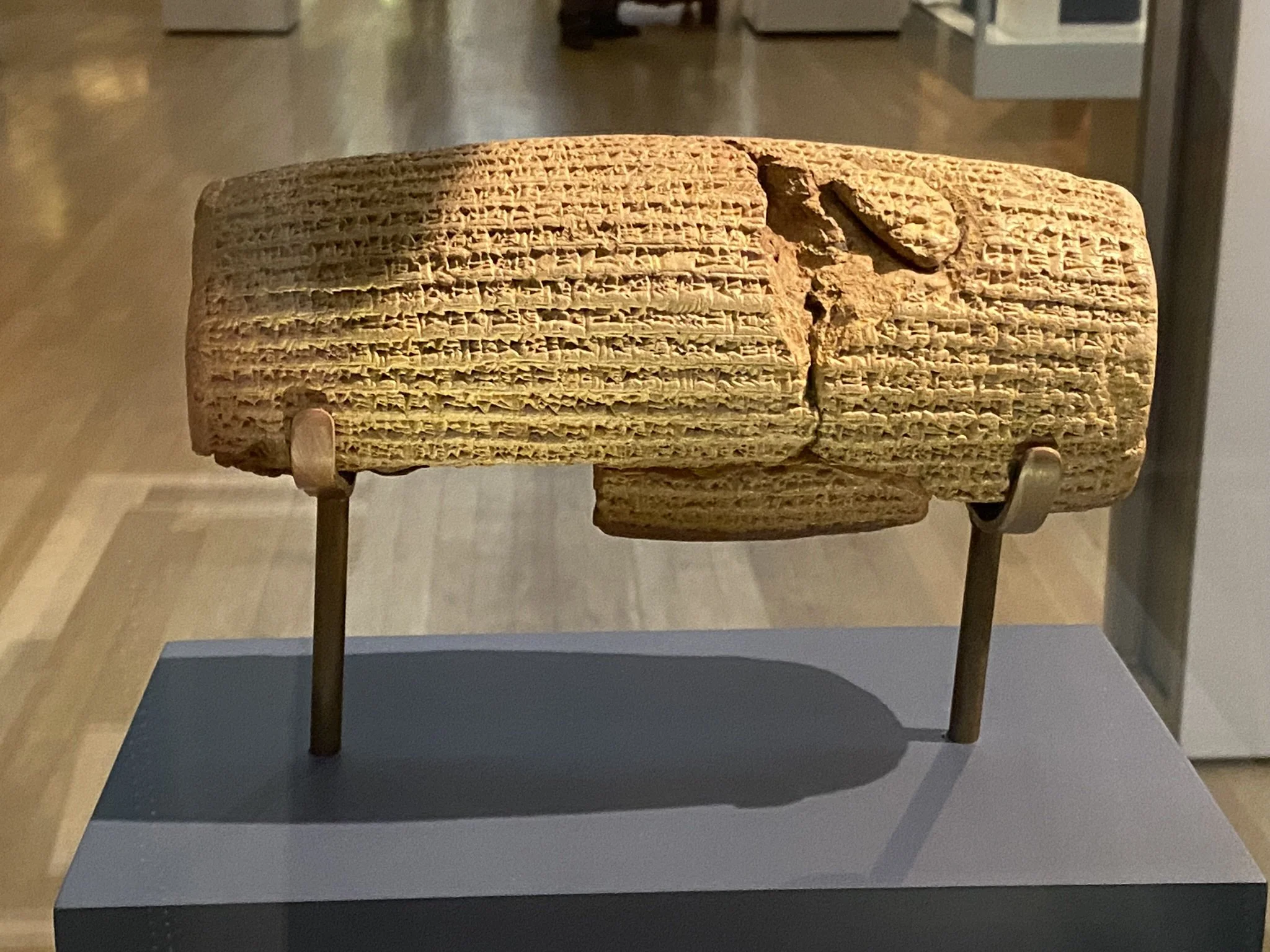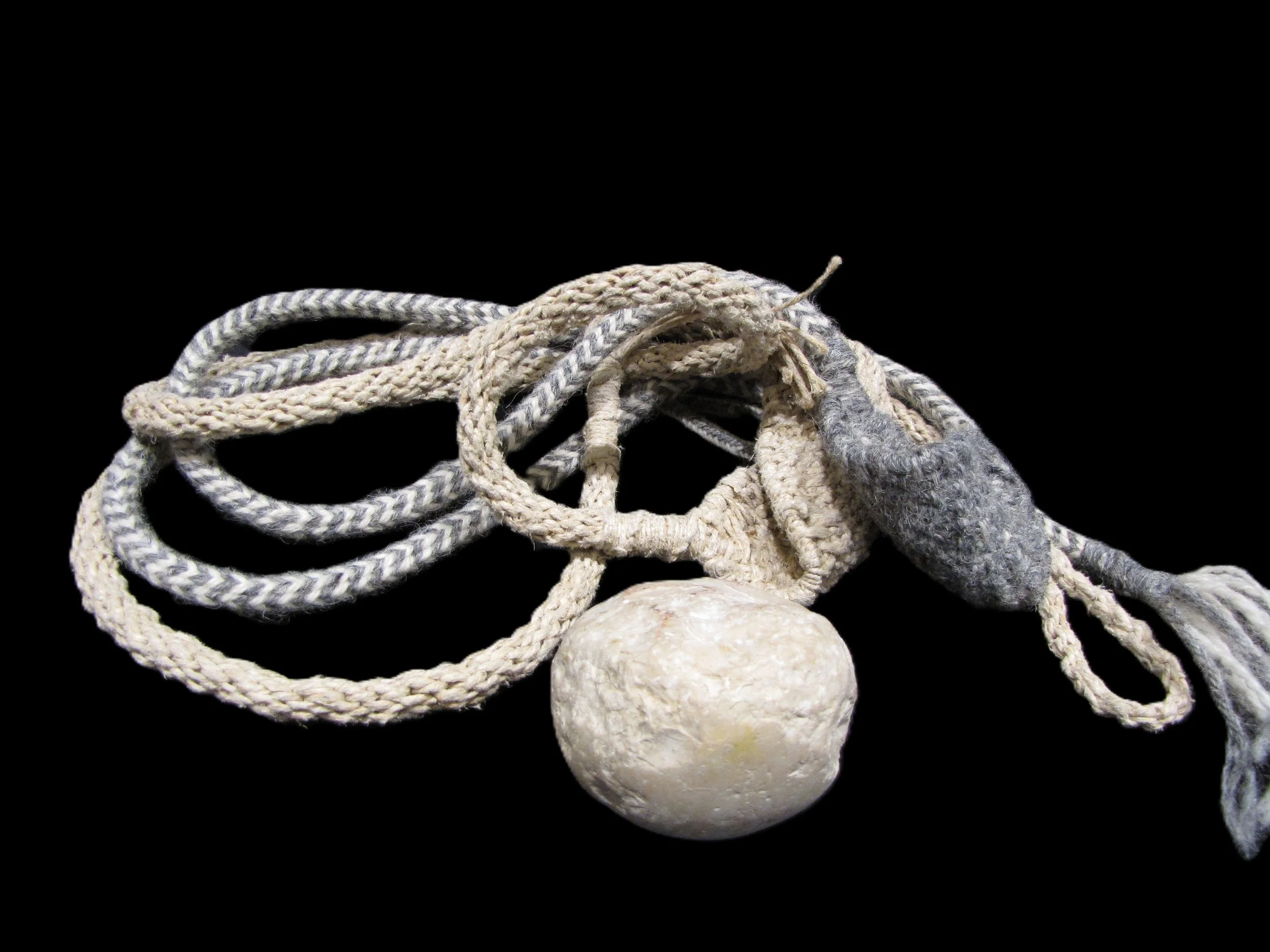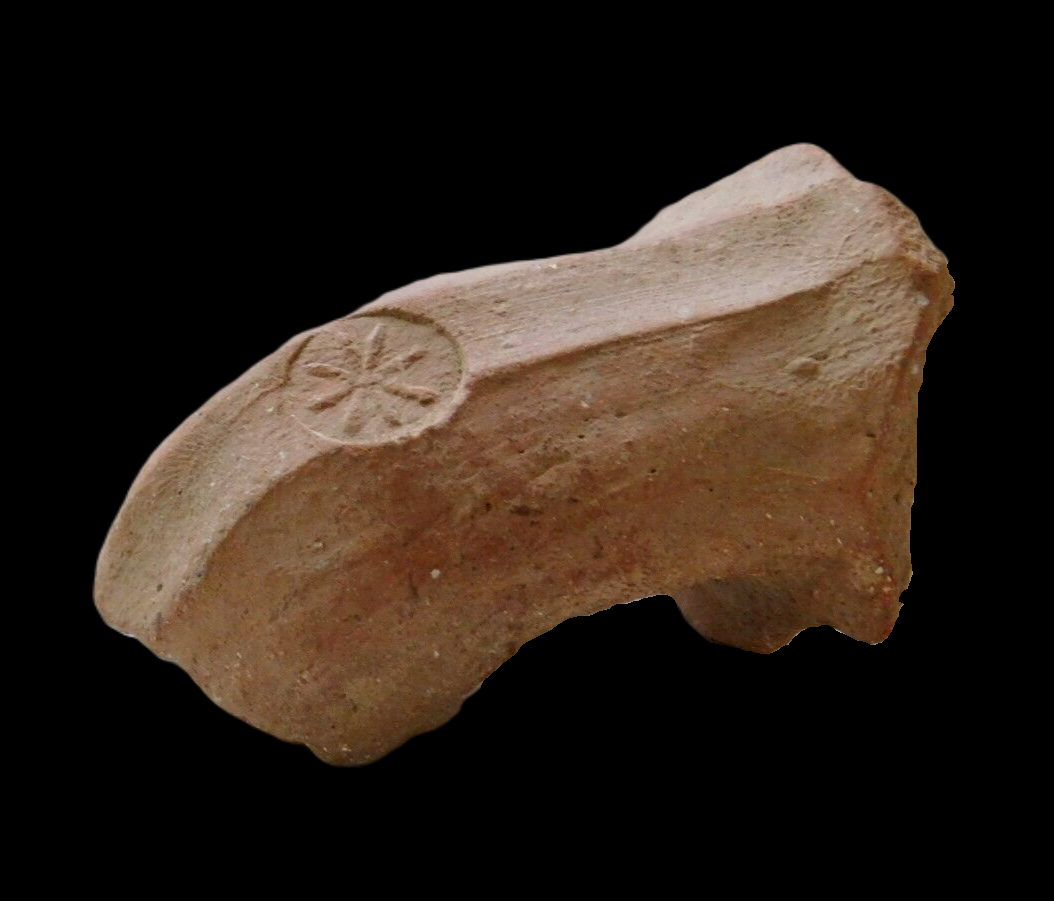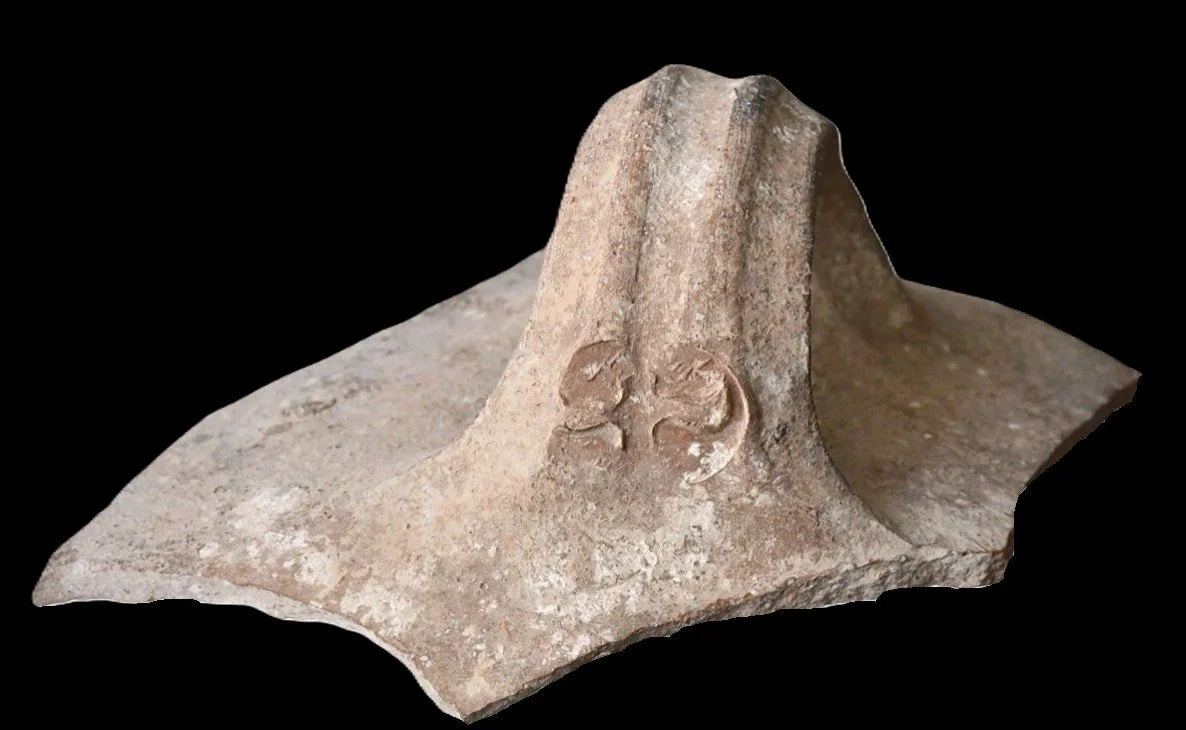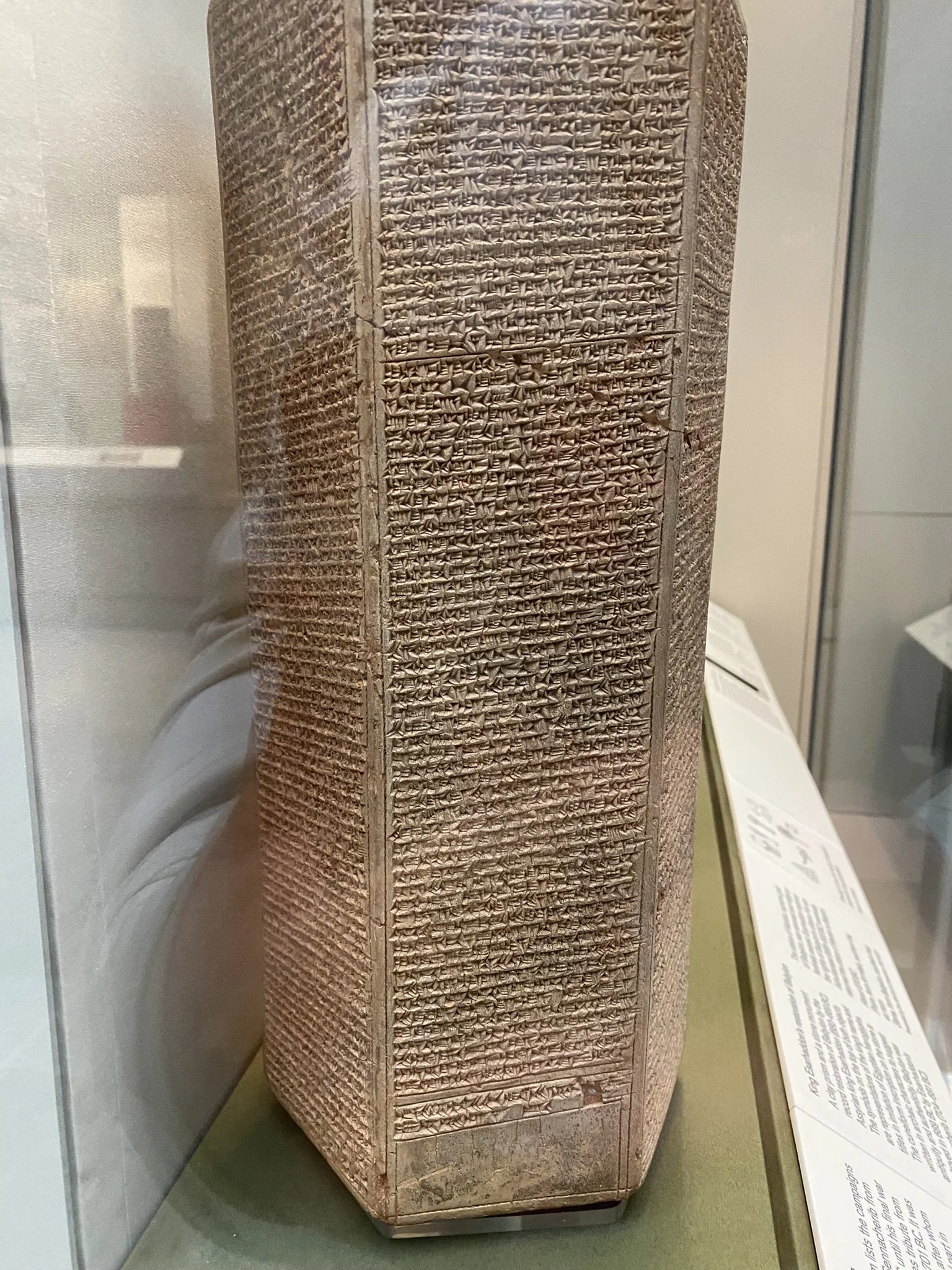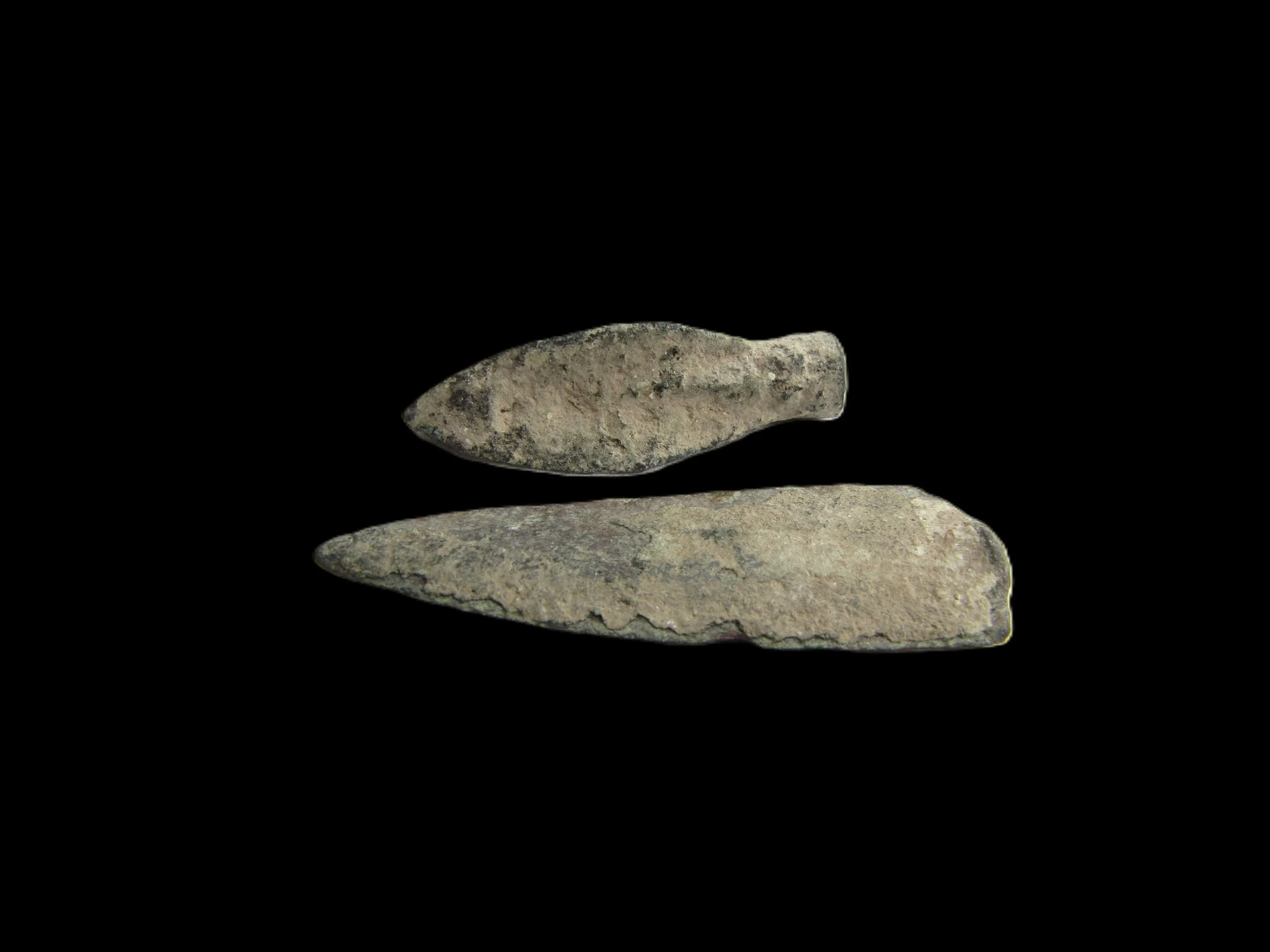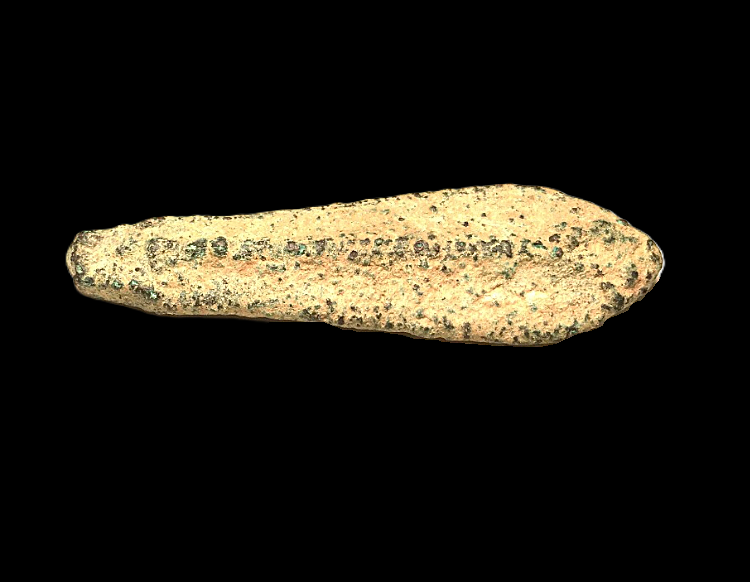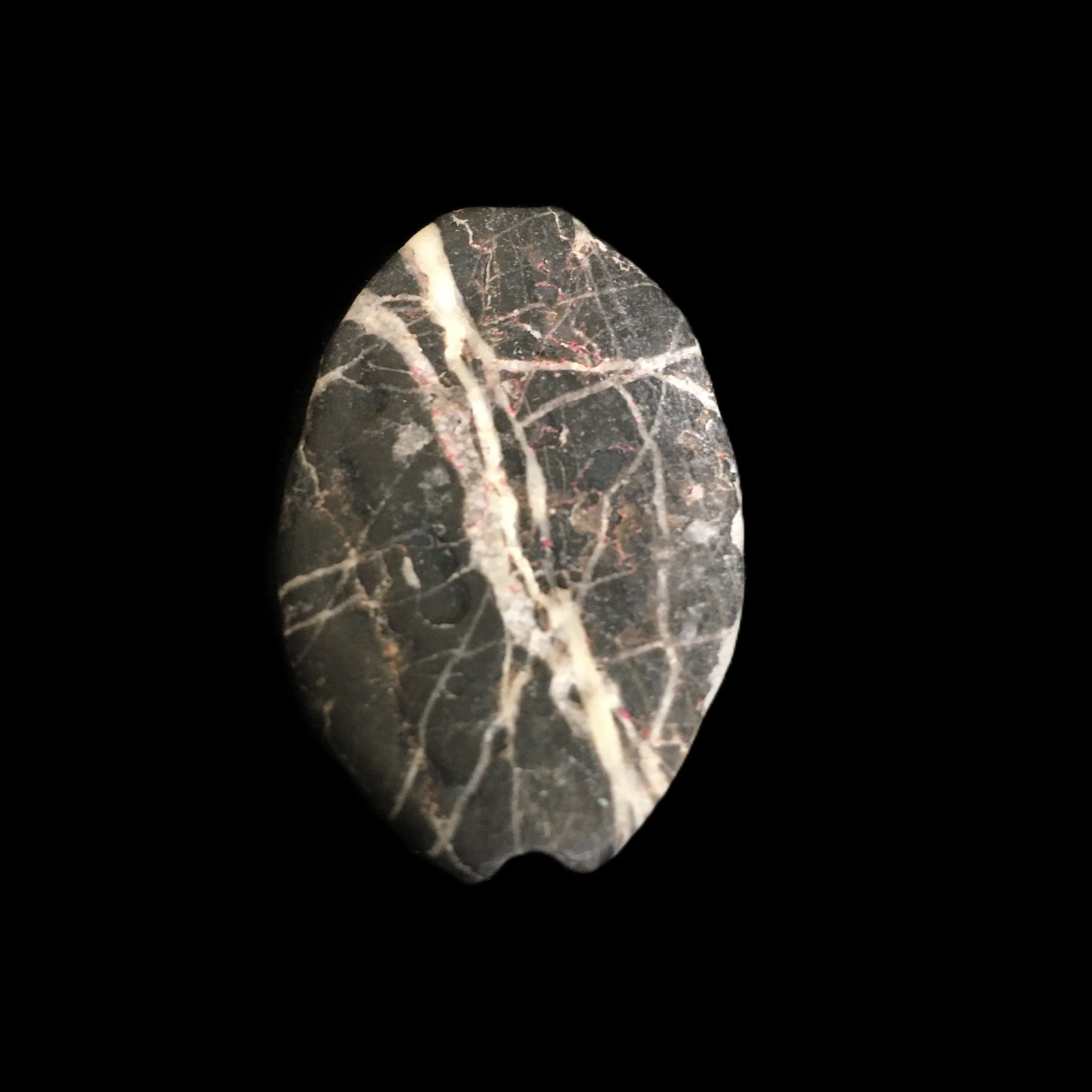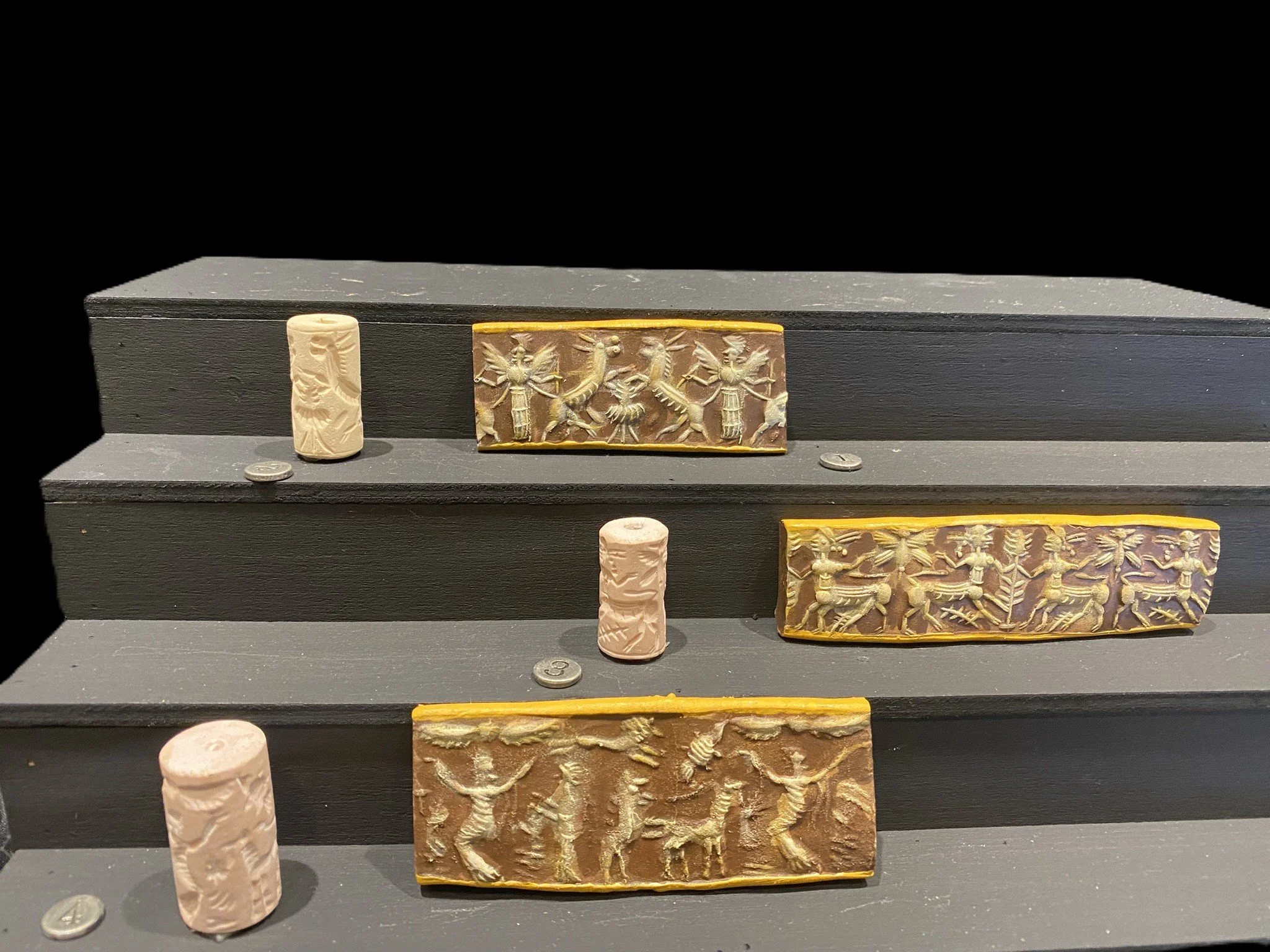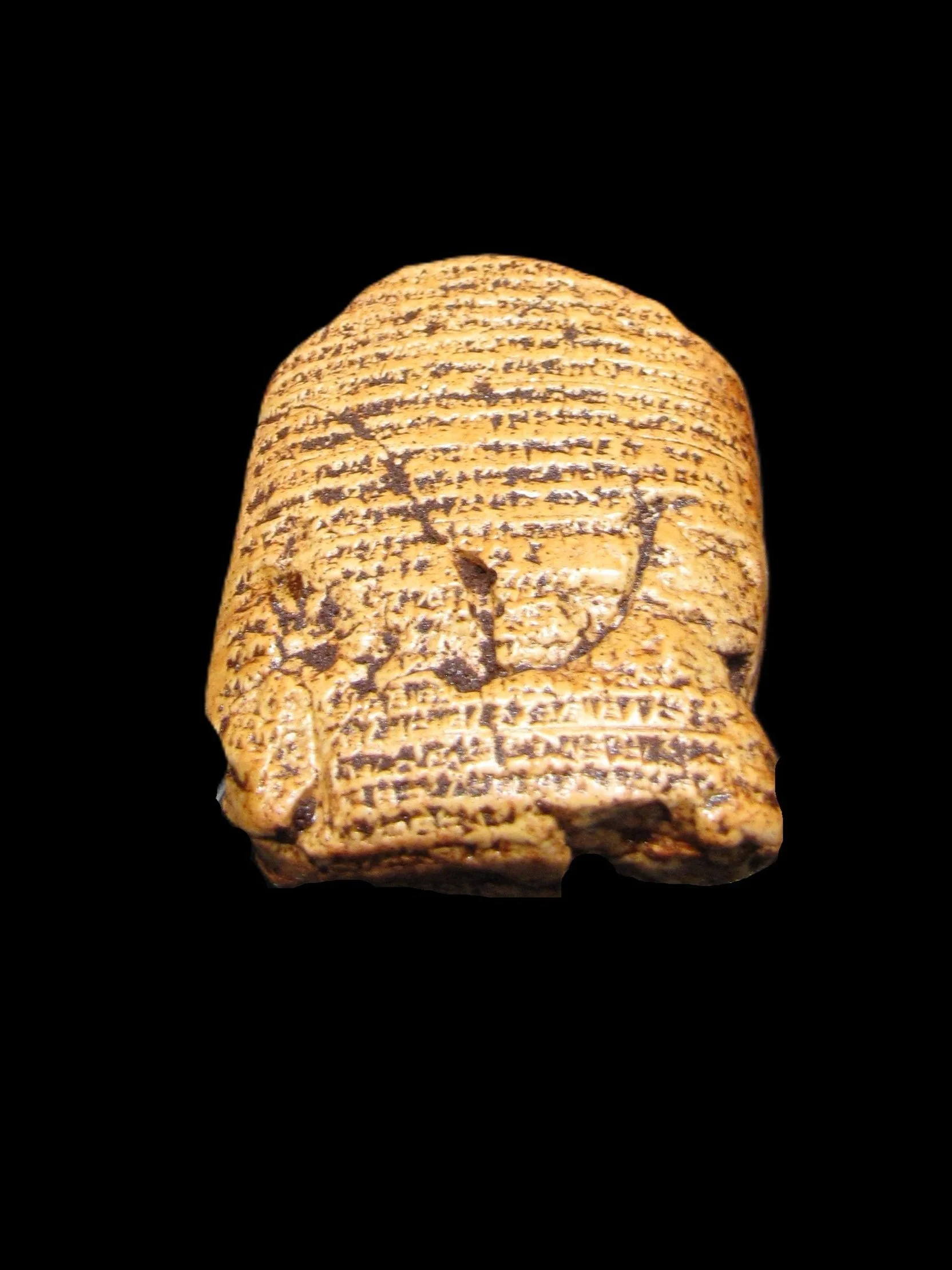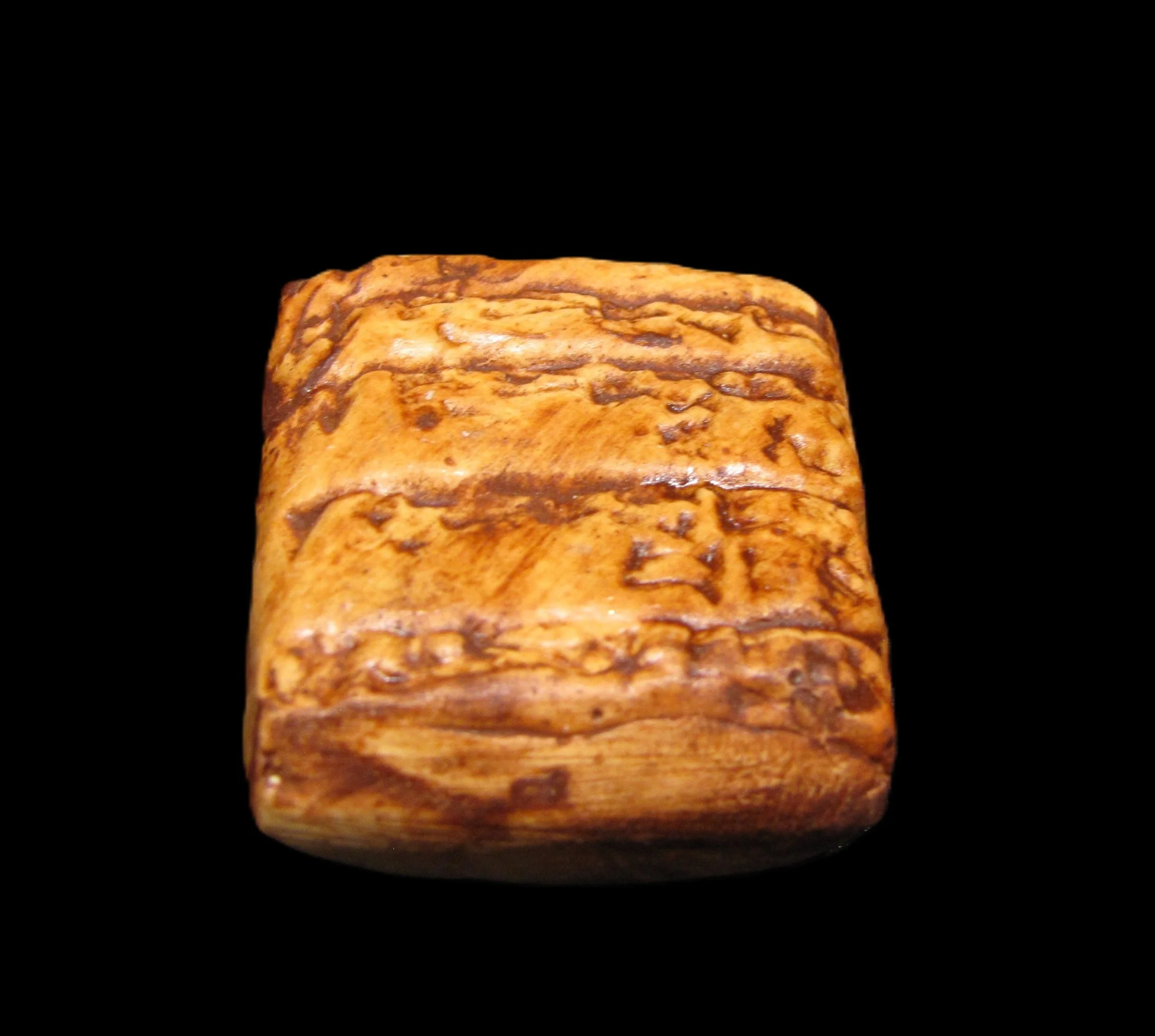Type: Jug
Age: 930-586 BC
Era: Iron Age II
Excavated: Hebron, Israel
Pottery from the “time of the kings”.
“You shall also make a lampstand of pure gold;…” You shall make seven lamps for it, and they shall arrange its lamps so that they give light in front of it. And its wick'-trimmers and their trays shall be of pure gold,” (Exodus 25:31-40. The Menorah stood within the Holy Place of the Tabernacle (and Temple), on the south side, to give light for the priests. One of the most familiar representations of the menorah is found on the Arch of Titus in Rome (commemorating his conquest of Jerusalem in 70 AD). Representations of the seven lamp artifact have been found in tombs and on monuments dating from the 1st century as a frequently used symbol of Judaism and the Jewish People.
Type: Replica of the Cyrus Cylinder
Original was created around: 558-530 BCE
Culture: Persian
This clay cylinder is inscribed in Akkadian cuneiform script with an account made by the famous king, Cyrus of Persia (558-530). The Cyrus Cylinder records his conquest of Babylon in 539 BC and the capture of Nabonidus, the last of the Babylonian kings.
The Cyrus Cylinder is an important discovery in the study of Biblical Archaeology because it speaks of Cyrus the Persian and his conquest of Babylon in 539 BC as mentioned in Scripture (see below).
Cyrus II, the Great, was the founder and ruler of the vast Persian Empire from 539 BC until his death in 530 BC. Once Cyrus defeated the Median king, Astyages, and took Ecbatana, he expanded his kingdom by defeating Croesus, king of Lydia in 546 BC, and then conquered Babylon in 539 BC, overthrowing the sitting king Belshazzar, son of the Nabonidus, who was directing a war in a distant country.
The historian Xenophon, the former king Nabonidus, and many others gave Cyrus praise for his generous leadership. In his generosity, Cyrus allowed various captives to return to their homelands, as recorded on the Cyrus Cylinder and prophesied 150 years prior by Isaiah the prophet.
“Who says of Cyrus, ‘He is My shepherd, and he shall perform all my pleasure, saying to Jerusalem “You shall be built,” and to the temple, “Your foundation shall be laid,” Isaiah 44:28.
Ezra wrote:
“King Cyrus also brought out the articles of the house of the Lord, which Nebuchadnezzar had taken from Jerusalem and put in the temple of his gods; and Cyrus king of Persia brought them out by the hand of Mithredath the Treasurer, and counted them out to Sheshbazzar the prince of Judah. This is the number of them: thirty gold platters, one thousand silver platters, twenty-nine knives, thirty gold basins, four hundred and ten silver basins of a similar kind, and one thousand other articles. All articles of gold and silver were five thousand four hundred. All these Sheshbazzar took with the captives who were brought from Babylon to Jerusalem,” Ezra 1:7-11
About the night of the Persian conquest, Daniel wrote:
“King Belshazzar gave a great banquet for a thousand of his nobles and drank wine with them. While Belshazzar was drinking his wine, he gave orders to bring in the gold and silver goblets that Nebuchadnezzar his father had taken from the temple in Jerusalem, so that the king and his nobles, his wives and his concubines might drink from them. So they brought in the gold goblets that had been taken from the temple of God in Jerusalem, and the king and his nobles, his wives and his concubines drank from them. As they drank the wine, they praised the gods of gold and silver, of bronze, iron, wood and stone.
Suddenly the fingers of a human hand appeared and wrote on the plaster of the wall, near the lampstand in the royal palace. The king watched the hand as it wrote. His face turned pale and he was so frightened that his legs became weak and his knees were knocking.” Daniel 5:1-6
The Historian Xenophon wrote about the night that Babylon was captured by the Persians:
“The trenches had already been dug. Since Cyrus heard that there was a festival in Babylon in which all the Babylonians drank and reveled the entire night, on this night, as soon as it was dark, he took many people and opened the mouths of the trenches toward the river… [Cyrus said], “Men, friends, the river has yielded us the road to the city. Let us enter with confidence, fearing nothing within, bearing in mind that the troops against whom we are now marching are the very ones we conquered when they had allies in addition to themselves, were all wide awake, sober, armed, and organized. Now we are going against them at a time when many of them are asleep, many are drunk, and all are disorganized.”
The Cyrus Cylinder in the British Museum
These are modern examples of ancient slings.
Many people today think of slings as toys. However, the Bible tells us that a young shepherd named David killed he giant Philistine, Goliath with a very accurately slung stone (1 Samuel 17:40, 49). The Israelites used slings as weapons of war (2 Kings 3:25). This stone was taken from the Valley of Elah, where David killed Goliath.
Did You Know?
Did you know that archaeologists who were digging in Gath, the city of Goliath (the giant David killed with a sling and stone) found an inscribed piece of pottery with the name Goliath on it? Although we can’t say for certain, it makes one wonder if this is the same person we read about in the Bible.
Type: LMLK Jar Handle Rosette Style
Age: 800-586BCE
Era: Iron Age
Culture: Judea
Excavated: Israel
LMLK basically means "belonging to the king." These jars were typically used to store products from different regions that were used for taxation or levied products used to pay tribute to foreign rulers. The Rosette seal was started by King Jehoiakim and ended at the time of the Babylonian destruction of Judea in 587/586.
This appears to be a Rosette type 4A.
Type: LMLK Hezekiah sealed jar handle
Age: 800-700 BCE
Era: Iron Age
Culture: Israelite
LMLK seals (with LMLK meaning 'of the king') are ancient Hebrew seals stamped on the handles of large storage jars first issued in the reign of King Hezekiah (Late 8 Century BC.) and discovered mostly in and around Jerusalem. Several complete jars were found in situ buried under a destruction layer caused by Sennacherib at Lachish. While none of the original seals have been found, some 2,000 impressions made by at least 21 seal types have been published. The iconography of the two and four-winged symbols are representative of royal symbols whose meaning "was tailored in each kingdom to the local religion and ideology.
Scholars believe that the LMLK jars were developed as a way to gather taxes (grain, oil, wine, etc.) from the cities of Judea. These taxes (stored in these LMLK jars) were used to pay off the Assyrian army who were sent to destroy Judea. The Bible states that Hezekiah was paying tribute to the Assyrian King Sargon; however after Sargon’s death, he decided to rebel. The next king of Assyria, Sennacherib, was very upset and started a military campaign against Judea. We learn that many of the Judean cities were destroyed, but, as the Bible states, Jerusalem was spared. This is confirmed by Sennacherib’s Prism. See information below.
Sennacherib boasts of his destruction of the Northern Kingdom of Israel and several of the fortified cities in the Southern Kingdom of Judea. This is chronicled on the Sennacherib Prism housed in the British Museum (pictured to the right). Hezekiah, the King of Judea, was reigning from Jerusalem at this time. Concerned about Sennacherib's threats, he sought the Word of the Lord through Isaiah the Prophet. The LORD told Isaiah that Sennacherib would NOT overtake Jerusalem (See Biblical reference below). This is alluded to in Sennacherib's own annals.
He states..."As to Hezekiah, the Jew, he did not submit to my yoke, I laid siege to 46 of his strong cities, walled forts and to the countless small villages in their vicinity, and conquered (them) by means of well-stamped (earth-)ramps, and battering-rams brought (thus) near (to the walls) (combined with) the attack by foot soldiers, (using) mines, breeches as well as sapper work. I drove out (of them) 200, 150 people, young and old, male and female, horses, mules, donkeys, camels, big and small cattle beyond counting, and considered (them) booty. Himself I made a prisoner in Jerusalem, his royal residence, like a bird in a cage. I surrounded him with earthwork in order to molest those who were leaving his city’s gate."
ANET: Page 288
Sennacherib never says he conquered Jerusalem, even after the siege, as confirmed in the Bible.
32 ‘Therefore this is what the Lord says about the king of Assyria: “He will not come to this city nor shoot an arrow there; and he will not come before it with a shield nor heap up an assault ramp against it. 33 By the way that he came, by the same he will return, and he shall not come to this city,”’ declares the Lord. 34 ‘For I will protect this city to save it for My own sake, and for My servant David’s sake.’” 35 Then it happened that night that the angel of the Lord went out and struck 185,000 in the camp of the Assyrians; and when the rest got up early in the morning, behold, all of the 185,000 were dead. 36 So Sennacherib the king of Assyria departed and returned home, and lived at Nineveh.
2 Kings 19:32-36 NASB
ANET : Ancient Near Eastern Texts Relating to the Old Testament. Third Edition with Supplement. Ed. James B. Pritchard. Princeton: Princeton Univ. Press, 1969
Type: Bowl
Age: 1000 BCE
Era: Iron Age
Culture: Israelite
Excavated: Israel
This bowl was in use during the First Temple period which is when King David, Solomon, and Rehoboam reigned.
Type: Arrowheads
Age: 600-586 BCE
Era: Iron Age
Culture: Babylonian-Persian
Arrowheads like these are commonly found in Jerusalem. Archaeologists believe that these arrowheads are from the Babylonian destruction of Jerusalem of 586 BC. The destruction was written about in Jeremiah, Ezekiel, and Daniel.
Type: Arrow Head
Age: 800 BCE
Era: Iron Age
Culture: Persian/Mesopotamian
Excavated: Persia/Iran
Type: Long Tine Arrow
Age: 1200-800
Era: Iran Age
Culture: Likely Luristan (A people who are thought to be the decedents of the Elamites)
Excavated: Unknown
Reference: Khonsarinejad, E., et.al. Historia I Swiat
Type: Altar Amulet (reflective of the four horned alter)
Age: 664-332 BCE
Era: Persian
Culture: Egyptian/Judean
Excavated: Unknown
I find this small amulet interesting due to its shape. The four horned alter was used throughout the near east, but most notably in the Jerusalem Temple. Sacrifice was to only occur at the Jerusalem temple; however, as the Judahites and Israelites fell away from following the LORD, they started to create different sacrificial areas (including the high places). As such, these types of alters have been found throughout Israel.
Click here for an example of Four Horned Incense Altar.
These impressions were obtained by pressing the material against the actual bullae.
1. Impression that states Gemeryahu son of Shaphan. The bullae that this impression is from comes from the 6th century BC. Gemeryahu is believed to be another way to spell Jeremiah (a common way to spell Judean names in this period). Gemeryahu was the son of Shapan, the Scribe. (Jeremiah: 36:10-12 and 2 Kings 22)
2. Impression that states Belonging to Baruch the Scribe. Baruch was the son of Neriah and became the scribe of the Prophet Jeremiah (Jeremiah 36:32). He wrote down the first and second editions of Jeremiah's prophecies as they were dictated to him. Baruch remained true to the teachings and ideals of the great prophet, although, like his master, he was at times almost overwhelmed by despondency. Both Baruch and Jeremiah witness the Babylonian siege of Jerusalem of 587-586 BC. Baruch's bullae may even retain his fingerprint. Some scholars believe this bullae is a forgery.
3. Impression that states “Belonging to Jerahmeael”, son of King Azriel. Jerahmael lived in in the 6th century BC (Jeremiah 36:26)
4. Impression that states “Belonging to Seriah”. Seriah was the son of Neriah and brother of Baruch. He lived int eh 6th century BC (Jeremiah 36:32).
5. Impression that states, "Belonging to Jotham." 750-735 BC. Jotham was a king of Juda, and son of Uzziah by Jerusha, daughter of Zadok. Jotham was 25 when he began h is reign, and reigned for 16 years. It is thought that his reign commenced as a coregency with his father, which lasted for 11 years. Because his father Uzziah was afflicted (possibly with leprosy) after he entered the Temple to burn incense, Jotham became governor of the palace and the land at that time, while his father lived in a separate house as a leper. The Gospel of Matthew lists Jotham of Judah in the genealogy of Jesus. He is recorded as having built the Upper Gate of the Temple of Jerusalem. Jotham was a contemporary of the prophets Isaiah, Hosea, Amos, and Micah, and benefited from their advice (1 Kings 15:32-38).
6. Impression that states "Belonging to Ahaz": 735-686 BC. Ahaz was king of Judah, and the son and successor of Jotham. He became king of Judah when he was 20 years old and reigned for 16 years. It is thought that Ahaz was coregent with Jotham from 736/735 BC, and that his sole reign began in 732/731 BC. His reign would have ended in 716/715 BC. The Gospel of Matthew lists Ahaz of Judah in the genealogy of Jesus. He is also mentioned in Isaiah 14:28. (1 Kings 16:1-20)
7. Impression that states "Belonging to Hezekiah:" 715-686 BC. According to the Hebrew Bible, Hezekiah was the son of Ahaz and the 13th king of Judah. He is one of the most prominent kings of Judah and is mentioned in Matthew's genealogy of Jesus. Hezekiah witnessed the destruction of the Northern Kingdom of Israel by the Assyrian Sargon in 720 BC, and was king of Judah during the siege of Jerusalem by Sennacherib in 701 BC. He enacted sweeping religious reforms, including a strict mandate for the sole worship of Yahweh and a prohibition on venerating other deities within the Temple in Jerusalem. Isaiah and Micah prophesied during his reign. Hezekiah is mentioned by name on Sennacherib's prism, an ancient (non-Biblical) document that supports the Biblical narrative.
8. Impression stating "Belonging to Manasseh": 697-642 BC. Manasseh was a king of Judah and the only son of Hezekiah with Hephzibah. He became king at the age of 12 and reigned for 55 years (2nd Kings 21:1-18 and 2nd Chronicles 32:33-33:20). He began his reign as a co-regent with his father Hezekiah in 697/696 BC. Manasseh was the first king of Judah who would not have had a direct experience with the Kingdom of Israel, which had been destroyed and scattered by the Assyrians in 720 BC. He re-instituted pagan worship and reversed the religious reforms made by his father Hezekiah; for which he is condemned in several texts. He died in 643 BC after a reign of 55 years.
What are Bullae? To answer this question we must first recognize that there are seals and bullae. A seal is an object that is inscribed on one side with words or pictures. This seal often served as a signature, which would be pressed into clay or wax thus leaving an imprint. These were often affixed to documents or objects. The clay or wax impression are called bullae which are often hardened to aid in preservation.
There are examples of seals (genuine and replicas) in these cases. For example, case two contains a Hyksos seal as well as a seal that has the name of Thutmose III. Many bullae related to Biblical figures have been found in archaeological digs or on the antiquities market. For Example:
1. "Belonging to Ahaz, son of Jotham, King of Judah."
2. "Belonging to Hezekiah, [son of] Ahaz, King of Judah."
3. "Shebnayahu [serven]t of the King."
4. "Isaiah prophet."
5. "[belonging] to Azariah son of Hilqiyahu"
6. "Belonging to Seriah son of Neriah."
7. " Belonging to Yehuchal son of Shelemiyahu son of Shovi."
8. "Belonging to Gedaliah son of Pashhur."
9. "Belonging to Gemeryahu son of Shaphan."
10."Belonging to Matanyahu son of Ho[...]."
11. "Belonging to Hanan sone of Hilkiah."
12. "Belonging to Elishama son of Semachiah."
13. "Belonging to Jerahmeel the king's son." Referencing King Jehoiakim.
14. "Belonging to Pedaiah, son of the king." The king would be Jehoiachin.
15. "Belonging to Hananiah son of Azariah."
16. "Belonging to Gedaliah son of Immer."
17. "Belonging to Shelemiah son of Shema."
18. "Belonging to Malchijah son of the king." The king would be Zedekiah.
19. "Belonging to Gedaliah who is over the house."
20. "Belonging to Jaazaniah servant of the king."
21. Belonging to Nathan Melek, servant of the King."
Some seals have been found. These Seals are from:
1. Jezabel wife of Ahab
2. "Yeho'ezer son of Hosh'ayahu."
Type: Replica Bullae of Isaiah the Prophet with an enlarged version next to it.
In 2009, archaeologists unearthed a bullae with the name Isaiah on it. It was found only feet away from where a Hezekiah bullae was found (see the bullae or seal impressions in this case for a pressing of the Hezekiah bullae). This is important because Isaiah prophesied and was a close confident of King Hezekiah. Unfortunately the bullae was damaged when they found it. As you can see, the top part was broken. Archaeologists believe that the top portion contained an image of a deer or doe; however, this is very speculative. The other damage was caused by the thumbprint of the person who pressed the seal into the clay (probably Isaiah himself). This thumbprint is on the left side of the bullae and has caused last letters to be distorted. The Middle section contains the name Isaiah. The bottom section contains three clear letters in ancient Hebrew ‘nvy’. The word for prophet is ‘nvya.’ Many archaeologists believe that the thumb of the person caused the last letter (the Herbrew Aleph or English A) to be obscured. Nonetheless, many strongly believe that this bullae reads “Isaiah Prophet”.
Type: Replica of the Nathan Melek bullae
Around 2019, the bullae of Nathan Melek was found in the City of David excavations. The bullae reads “Belonging to Nathan Melech, Servant of the King.” Who was Nathan Melek? In 2 Kings 23:11 we read “He (King Josiah) removed from the entrance of the temple of the Lord, the horses that the kings of Judah had dedicated to the sun. They were in the court near the room of an official named Nathan Melek. Josiah then burned the chariots dedicated to the sun.”
Type: Replica Seal of Jezebel Queen of Israel.
Unbeknownst to the owner, and tucked away in their private collection, existed an extremely important royal seal; the seal of Queen Jezebel. It wasn’t until an archaeologist did an extensive study of the seal that the owner’s identity was revealed. This seal is remarkable, because of the thousands found, only 32 belonged to a woman. As with anything in the field of archaeology, there is still debate as to the reading of the seal. Nonetheless, many are convinced this is the seal of Jezebel.
Jezebel was married to King Ahab who ruled over the Northern Kingdom of Israel between 847-853 BC. The Bible does not speak fondly of Jezebel, as she attempted to kill all of the Prophets of the Lord and even had a man killed because Ahab wanted his garden.
The person who replicated this seal filled in a broken piece from the top and added blue to accentuate the different iconography.
Type: Proto-Syrian (Assyrian) Marbled Stone Stamp Seal with reported animal motif.
Age: 1000 BCE
Era: Iron Age
Culture: Assyrian
Excavated: Unknown
A little about the Assyrian Empire in association with the Biblical text.
The Assyrian Empire emerged as a powerful independent state in the late Bronze Age; around 1400 BCE. Several Assyrian leaders are mentioned in the Bible including Tiglath Pileser III, Shalmaneser V, Sargon II, Sennacherib, and Esarhaddon. Similarly, Israelite and Judahite kings are mentioned in the annals of the Assyrian Kings. For example, the Annals of Tiglath Pileser III, mentioned receiving tribute from King Johoahaz (Ahaz) of Judah.
Type: Oil Lamp
Age: 1020-567 BC
Era: Iron Age
Excavated: Jerusalem
The first part of the Iron Age (Israelite Period) was the time of the reigns of Saul, David, and Solomon (1020-930 BC). Oil Lamps like these (found in Jerusalem) were the only sources of light after dark or in closed spaces.
Type: Pottery from Samaria
Age: 835-722 BC
Culture: Samarian/Israelite
These pottery pieces came from the ancient city of Samaria (capital of the northern kingdom of Israel). There is writing n the piece of handle. Most of these pieces where handed to Pastor Terry by children on the dig site. Samaria had an excellent hilltop location (300 feet high) forty miles north of Jerusalem and 25 miles from the Mediterranean sea. The city withstood several sieges by the Syrians, and a 3-year siege by the Assyrians before it fell (2 Kings 17:5). This is especially interesting in view of the fact that the city’s spring was a mile away and the inhabitants had to rely on cisterns (underground reservoirs of collected rain water). The city of Samaria is referred to over 100 times in the Old Testament although it was not built until about 50 years after the death of Solomon. It was founded in 845 BC by Omri, who died before completing the new city. It was finished by his son Ahab.
Regarding the handle, to the best of our limited ability, we believe that the letters come from a middle semitic script which typically dates from 1200 BC until 400 BC. It is believed that the top register reads Yad, Hey, Ayin, Doled in Hebrew. The English equivalent would be YH-D, the Ayin being a silent letter. There are three letters that are clear on the bottom register, Pey, Shin, Nun. The meaning of this word is uncertain. Note, that this is conjecture and needs further study.
Type: Replica of a “lot” owned by Lahali
Original Date: 800 BC
This small cube is a reproduction of one that belonged to Lahali, a high official of Shalmaneser III, who ruled from 858-823 BC. The cuneiform inscription reads: “…the lot of Lahali the grand vizier of Shalmaneser king of Assyria…assigned to him by lot, may the harvest proper and thrive, in front of the gods Assur and Adad may his lot fall.” The Roman solders “cast lots” to divide up Jesus’ clothing after his crucifixion (Matthew 27:35). The disciples of Jesus “cast lots” to determine who should replace Judas as a twelfth apostle (Acts 1:26)
The original tablet in the British Museum.
Replica of the Epic of Gilgamesh Flood Story
This Assyrian cuneiform tablet was written in approximately 700 BC. This tablet is humankind’s oldest reference to the great Deluge, outside of the Bible. The tablet shares several lines from the beginning of the Biblical Flood story, which is the forerunner of he Babylonian Gilgamesh Epic and the source of the Atra-Hasis Myth. According to the British Museum, this tablet (eleventh of the thirteen Gilgamesh tablets), is perhaps the most famous in the world. The tablet describes how the gods sent a flood to destroy the world. Like Noah, Utnapishtim is forewarned and builds an ark to escape and preserve living things. Humankind is destroyed while Utnapishtim survives, finally landing on a mountain called Nimush. After he flood he sends out birds to find dry land.
Excavated from the Nineveh Library of Ashurbanipal by A.H. Layard in the mid 19th century, commentators agree that the story hails from a a much earlier period, not long after the flood described in the story. One of the few kings of antiquity who could read and write, Ashurbanipal created an extraordinary underground library at Nineveh, where he gathered all ancient texts, tablets and literature available, dispatching emissaries as far as India, Egypt and Thrace. The Gilgamesh set was amongst the 50,000 tablets recovered. This Assyrian version of the Old Testament flood story was identified in 1872 by George Smith, an assistant at the British Museum.
“O man of Shuruppak, son of Ubartutu: Tear down the house and build a boat! Abandon wealth and seek living beings! Spurn possessions and keep alive living beings! Make all living beings go up into the boat. The boat which you are to build, its dimensions must measure equal to each other: its length must correspond to its width. Roof it over like the Apsu.
“You gods, as surely as I shall not forget this lapis lazuli around my neck, may I be mindful of these days, and never forget them! The gods may come to the incense offering, but Enlil may not come to the incense offering, because without considering he brought about the Flood and consigned my people to annihilation.”
The Epic of Gilgamesh, Tablet XI, “Belet-ili, Ishtar as the mother goddess, after the Flood.”
Type: Replica Syrian/Assyrian Cylinder Seals
Original Seals: 700-300 BC
Culture: Assyrian/Syrian
Top Cylinder Seal: Ishtar Rising (Assyrian 700 BC) engraved Assyrian seal from the 6th century BC. Fashioned solely with angled cutting wheels, the seal reflects a medley of Akkadian and Babylonian influence, including an early version of the classic winged disc adopted into a Syrian iconography from Egypt.
Middle Cylinder Seal: Mythic Centaurs (Ancient Syrian Seal 300 BC) seal typifies the period of Greek expansion into Mesopotamia around 300 BC. Seals from this time reflect an interesting cross fertilization of Greek and Mesopotamian mythology. It depicts a pair of Greek style centaurs standing either side of the classic tree of life symbol. The infamous demon storm bird Zu hovers in the sky above them.
Bottom cylinder seal: Syrian Seal 800 BC. Winged goddess engraved stone seal from ancient Syria circa 800 BC. Cylinder seal of a governor or royal official originally fashioned with hand powered cutting wheel and drill. The seal depicts a winged goddess standing between horned bulls, an early Assyrian version of a classic scene.
Replica of the Babylonian Chronicles a Babylonian baked clay tablet, circa 550-400 BC, found in Babylon (Southern Iraq).
Translated in 1956, it was found to be an historical account of events in Babylon from 605 to 594 BC following the collapse of the Assyrian Empire. The tablet is part of what’s known as the “Babylonian Chronicles,” a series of tablets recording major events in Babylonian history written over a long period by the Babylonian astronomers known as the Chaldeans. Each entry is separated by a horizontal line and begins with a reference to the year of reign of the relevant king.
The text relates three key historical events:
The Battle of Carchemish, Nebuchadnezzar of Babylon defeats Pharoah Necho of Egypt in 605 BC.
The accession to the throne of Nebuchadnezzar II the Chaldean.
The capture of Jerusalem in 598 BC, which compares with Biblical accounts of the same event.
Following the Assyrian defeat, the Egyptians remained the greatest threat to the Babylonian security. In 605 BC the Babylonian crown prince Nebuchadnezzar replaced his father Nabopolassar as commander-in-chief and led the army up the Euphrates to the city of Carchemish where he defeated the Egyptians. Later that year Nabopolassar died and Nebuchadnezzar returned to Babylon to be crowned. Over the next few years he maintained control of Syria, extending into Israel. In 601 BC he marched to Egypt but withdrew on seeing the size of the Egyptian army. After equipping his army, Nebuchadnezzar marched to Syrian in 599 BC. He traveled westwards again in December 598 BC, as Jehoiakim king of Judah had failed to pay tribute. Nebuchadnezzar’s army attacked Jerusalem and captured it on 15th/16th March 597 BC. Jehoiachin, the new king of Judah, was taken prisoner and removed to Babylon. The chronicle ends in 594 BC with a series of expeditions to Syria.
Did you know?
Did you know that a tablet was found in Babylon that lists the rations given to king Jehoiachin by the Babylonian king. This is the same Jehoiachin that was taken captive by the Babylonian King Nebuchadnezzar and taken to Babylon. This confirms the Biblical narrative.
Replica of an Assyrian-Akkadian cuneiform tablet
This is closely inscribed on both sides in Assyrian-Akkadian from circa 800 BC.
Type: Black Ware Jug
Age: 1000 BCE
Era: Iron Age
Culture: Israelite
Excavated: Hebron
This type of jug was typically used for dipping from a larger jug. The larger jug had a spout and another raised area where this jug would sit, for storage.
Hebron is a very important city, one of the oldest in Israel. The Bible states that Abraham lived in Hebron at one point and King David reigned from Hebron for the first seven years. This jar, theoretically, could have been used at the time of David's reign.

